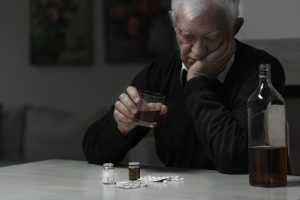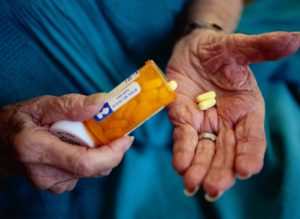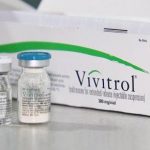 Drug abuse and alcoholism have been hot topics across our nation as of late. We are currently in the midst of one of the worst health crises of the past 100 years; the opioid epidemic. Thousands of Americans are dying each year from fatal overdoses linked to heroin, prescription medication, and synthetic drugs that are smuggled in from China and Mexico. Understandably, as more parents bury their children from drug abuse, we focus on how we can help the younger generation of addicts. Nonetheless, there is an invisible epidemic on our hands.
Drug abuse and alcoholism have been hot topics across our nation as of late. We are currently in the midst of one of the worst health crises of the past 100 years; the opioid epidemic. Thousands of Americans are dying each year from fatal overdoses linked to heroin, prescription medication, and synthetic drugs that are smuggled in from China and Mexico. Understandably, as more parents bury their children from drug abuse, we focus on how we can help the younger generation of addicts. Nonetheless, there is an invisible epidemic on our hands.
Baby boomers, as well as adults 45 and older, are using and abusing alcohol and drugs at increasing rates. From binge drinking, to smoking more marijuana, to abusing prescription medications, such as benzodiazepines and opiates, seniors are just as much at risk for a substance abuse disorder. As we have said in the past, addiction does not discriminate. It does not care where you are from, how much money you make, or how old you are. Just as it is possible for someone to recover from drug abuse and alcoholism at a young age, those 50 and older have the same opportunity. It is never too late to seek treatment, but first, we have to be aware of the problem, and let those affected know that such help exists.
What’s The Problem?
Recently, many studies have revealed shocking results surrounding drug abuse and alcoholism among Baby Boomers. Unfortunately, there is no one cause for the increasing rates, and regrettably, there are several substances in which seniors are abusing. Below, we have listed the different drugs baby boomers are now using at alarming rates.
Alcohol
A new study published in the journal of Alcoholism: Clinical and Experimental Research found that older adults are now consuming alcohol at higher rates. Their research focused on 145,000 responses to the National Health Interview Survey between 1997 through 2014. While both older men and women were found to be consuming alcohol at increasing rates, women are now closing the gender gap on drinking habits. In 1997, 54% of men and 37.8% of women were reported “current drinkers”. By 2014, those numbers increased for both genders. Men, aged 60 and over, rose to 59.9%, whereas women rose to 47.5%, making the margin of difference between genders much smaller.
Prescription Opiates
Baby Boomers and other seniors are at just as much risk from prescription opiates, as are the younger generations; just let the numbers speak for themselves. Although senior citizens make up less than 15% of our population, they consume more than 30% of all prescription medications. Also, the Associated Press reported that one third of Medicare beneficiaries received at least one prescription for opiates, as well as refills, such as OxyContin and Fentanyl in 2015.
Benzodiazepines
A study published in the Journal of the American Geriatric Society tells us that older adults are continuing to be prescribed benzodiazepines, such as Valium and Xanax, without being offered psychotherapy first and foremost. Additionally, according to data retrieved by IMS Health, which is responsible for tracking drug dispensing, between 2009 and 2013, the number of seniors who received a benzodiazepine prescription rose 12%, to 28.4 million individuals.
Illicit Drugs
Alcohol and prescription medications are not the only substances that Baby Boomers and seniors are using and abusing. Reports also make it clear that illicit substances, such as cocaine, heroin, and marijuana are also being consumed by the older populations as well. According to the Drug Abuse Warning Network, between 2004 and 2010, a horrifying number of seniors visited Emergency rooms with drugs in their system. For marijuana, that number went from 3,671 in 2004 to 14,019 people in 2010. Heroin-related visits went from 10,444 to 14,577, and cocaine-related visits are most shocking. In 2004, 16,501 individuals aged 55-64 visited the ER with cocaine in their system, whereas that number nearly tripled in 2010, to 42,689.
Understanding The Problem
As you can see, it’s clear that drug abuse and alcoholism is certainly not a generational issue. It has crossed all boundaries, affecting the young, the old, and everyone in between. While so much focus has been on millennials and their drug abuse problems, we have forgotten and side-lined a large demographic of people. It is important to know the facts, understand the risk factors for seniors with substance abuse disorders, and how we can help. Although there is no one specific answer as to why so many seniors are becoming addicted, there are many factors and triggers that can contribute to the problem. Some examples include:
- Multiple prescriptions
- Retirement
- Loneliness
- Loss of a spouse
- Relocation into a nursing home
- Boredom/Lack of purpose
- Cognitive decline which can lead to mixing prescriptions/alcohol
Furthermore, the Centers for Disease Control and Prevention report that those aged 45 to 64 accounted for 44% of overdose deaths in 2013 and 2014. And, if these numbers aren’t enough, rising treatment admissions also prove that more seniors are struggling with drug abuse and alcoholism. Between 1992 and 2010, those aged 50 years or older that were admitted to a substance abuse treatment center rose 136%. Although alcohol is most commonly the reason for admission, heroin use admissions nearly doubled and cocaine admissions tripled.
In the end, Baby Boomers and other seniors should not be forgotten about. It’s evident that this demographic surely faces many triggers and stressors that often lead to drug abuse and alcoholism. If you know a senior that is struggling with addiction, there are programs available that are designed to address the specific needs of older adults. Again, it doesn’t matter how old someone is. Recovery is possible for everyone. If they are in need of treatment, please seek out the help of an addictions’ specialist. As we continue to fight against drug abuse in our country, we must not leave our Baby Boomers behind!
Contact Clearbrook For Drug Abuse Treatment
For more than 40 years, Clearbrook Treatment Centers has been providing effective, quality treatment for those struggling with drug abuse and alcoholism. If you or a loved one is in need of help, we would be more than happy to assist you. Please contact our Admissions Specialists today and begin your intake process. They are available 24 hours a day to answer any questions you may have.








